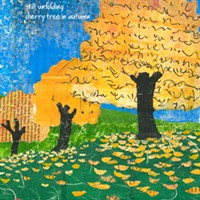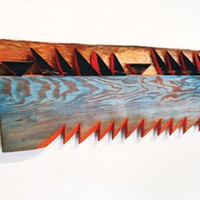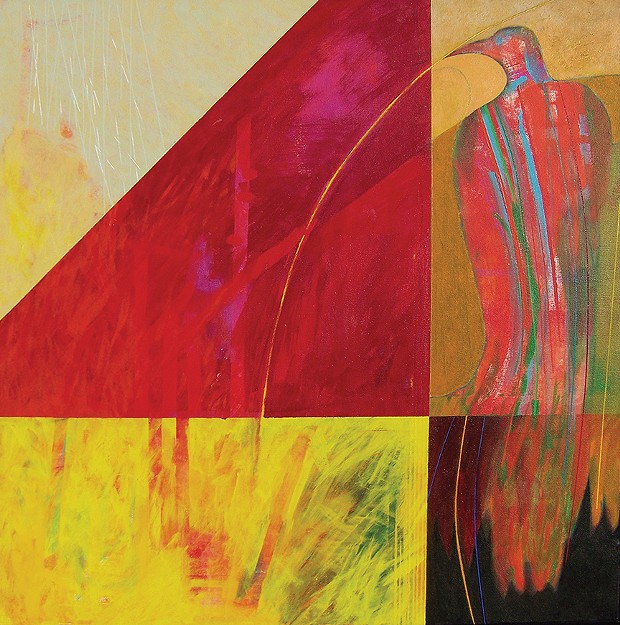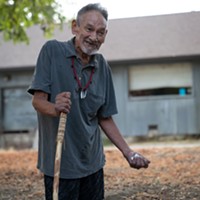[
{
"name": "Top Stories Video Pair",
"insertPoint": "7",
"component": "17087298",
"parentWrapperClass": "fdn-ads-inline-content-block",
"requiredCountToDisplay": "1"
}
]
In the angled October light of his Orleans home, Brian Tripp slips a simple hitch knot over the leg of his latest woodpecker sculpture and raises it to just above eye level. Like many of Tripp's sculptures, the bird is a deceptively simple assembly of branches, shaved redwood fragments, matte-black acrylic paint and carefully selected stones. Stripes of red and white compliment the black form, while small triangular mirrors adorn each feather. Hanging from Tripp's strong, sinewy arm, the bird spins, bouncing fragments of sunlight across his chest.
Tripp created this new piece for a group show with Leatrice Mikkelson and Frank LaPena this month at Piante Gallery's seventh annual Native American art show.
This particular woodpecker is named Icarus. His head angles, agonizingly eyeing the ground. His wings fold back as if he's falling. A rock duct-taped to one of its legs gives the bird a rakish tilt. As Tripp stands on his modest back porch, the Klamath babbles in the background and birds flit and chirp above. The Karuk artist slowly rotates Icarus, a reinterpretation of the Greek tragedy that, coming from a Native American, can be seen as a warning, alerting the rest of us to our potentially arrogant demise.
However, Tripp's sculpture is more than a cautionary tale. In its effortless blend of disparate cultural ingredients, this bird also exemplifies the multifaceted beauty often seen in contemporary Native American art. Modern masters like Tripp, Mikkelson and LaPena fluently balance Native American symbols and imagery in understated harmony with western aesthetics. Icarus may be falling, but over the last several decades, Indian art has been consistently on the rise.
Eureka artist Leatrice Mikkelson has seen this ascension first hand. Art has been a constant throughout her life, and as a Bay Area master's student in the '60s, she sought a professor who could teach her about contemporary Native American art. Even at UC Berkeley, she found no such expert. After graduating, Mikkelson struggled to find a gallery that would accept her art. Although her Western training was evident, her art was also deeply influenced by her Navajo, Cherokee and Wintu heritage. Gallery owners considered it "primitive," she says, and "simply didn't have a clue for anything about Native American art, especially a modern artist." Frustrated, Mikkelson put her professional aspirations aside and actively sought out opportunities and venues for contemporary Native American artists. Through these efforts, she met fellow artists like Brian Tripp and Frank LaPena.
As a young boy, Frank LaPena was sent to a federal boarding school and didn't return to seek out his immediate Wintu family until after high school. The experience established within him a deep understanding of the importance of his ancestral home and how the land and his tribe connect him to life both spiritually and physically. Since his first solo show in 1960, LaPena's prints, paintings and sculptures have been informed by the aesthetics of Western art, but place a higher priority on the teachings he received from elders in the Native American community. Now, as a professor emeritus at CSU Sacramento and master dancer and singer, LaPena has worked toward the recognition of traditional Native American expressions as true art forms. His artwork references traditions such as dancing and singing through form and design, weaving together his experiences in both Western and Native American cultures.
When LaPena begins painting, he doesn't have an end result in mind. He stays open to influences from both the physical and spiritual worlds. For "December 28, 2006," LaPena began by thinking about fire and how Indians' homes were burned in attempts to drive them from their native lands. As he worked, a face emerged. A week later he learned that two close friends had died on the same day he was painting. After that, LaPena pushed beyond fire and flame to incorporate elements that symbolized the passing of life and time. Separated into quadrants, the lower left corner of the painting glows with streaks of dandelion yellow, while shafts of red reach up into an area of flaming fuchsia. To the right, the form of a bird emerges from flames, its body dressed in long strokes of pine green, turquoise and garnet. It peers across the painting to a large triangle of ivory, raked with a palette knife to resemble streaks of rain. The quadrants are balanced by circular elements, evoking the cyclical nature of life, death and renewal.
Tripp, Mikkelson and LaPena each rely on a process that involves a personal journey, an exploration of visual imagery without a predetermined end. Their images connect an awareness of their heritage with the intimate experiences of living in the modern world. Traditions are alive in their work, even if those traditions have been envisioned through a contemporary lens.
Piante Gallery will hold a reception for the artists on Nov. 2 from 6 p.m. to 9 p.m.
Speaking of...
-

Annette Makino's Life in Collage
Dec 21, 2023 -

Full Circle Journey
Oct 26, 2023 -

Disaster Response, Crowley, Art in Piles and Salsas
Sep 7, 2023 - More »
more from the author
-
Porcelain Reborn
CR's group show honors the porcelain city
- Mar 5, 2015
-
The Prolific Hermit
Painter John Motian at Piante Gallery
- Feb 5, 2015
-
Perfectly Imperfect
Lauryn Axelrod's wabi-sabi vessels at Fire Arts Center
- Jan 8, 2015
- More »


































